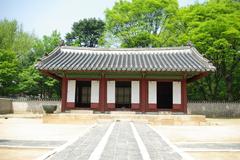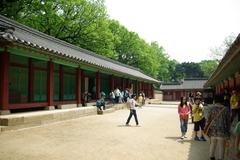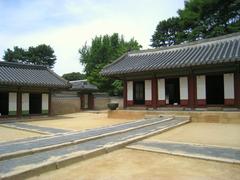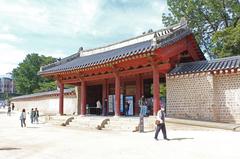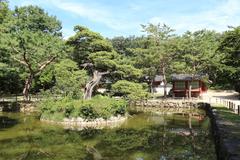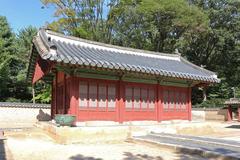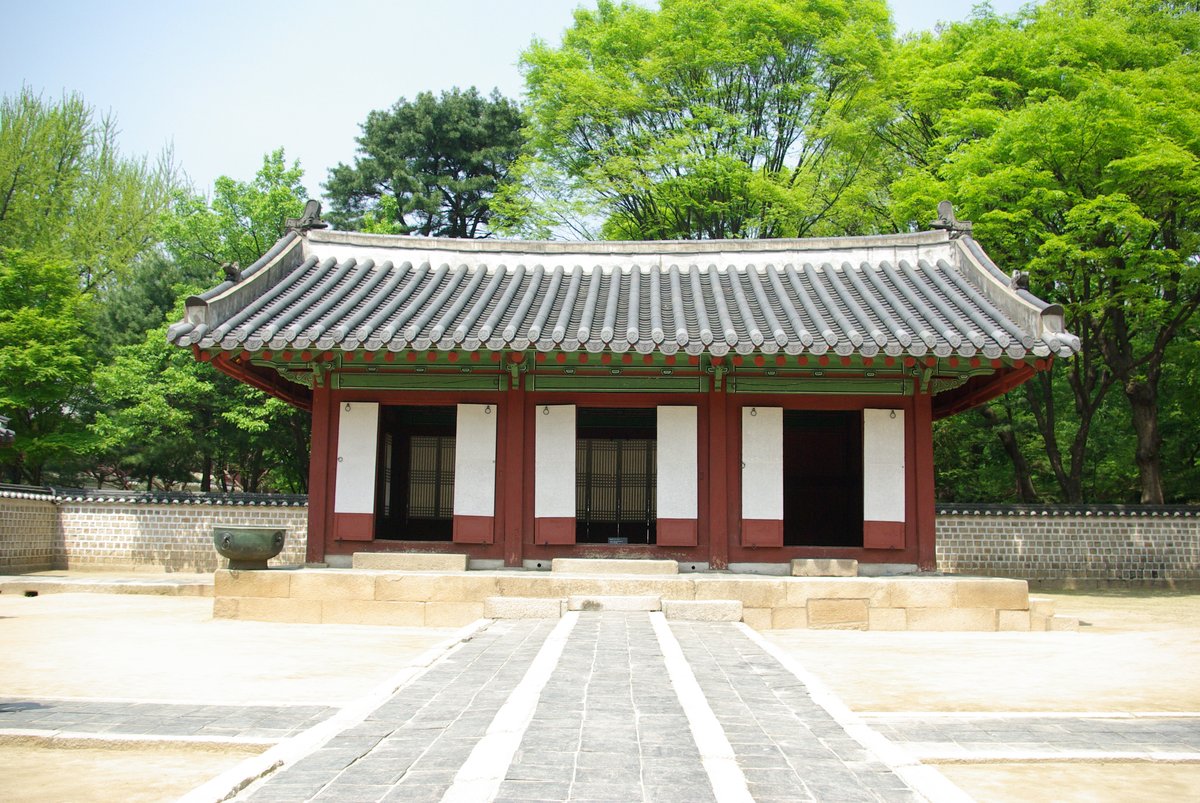
Jongmyo Shrine Visiting Hours, Tickets, and Seoul Historical Sites Guide
Date: 14/06/2025
Introduction to Jongmyo Shrine and Its Cultural Significance
Located in the vibrant heart of Seoul, Jongmyo Shrine stands as a profound symbol of Korea’s dynastic heritage and Confucian traditions. Established in 1394 by King Taejo, founder of the Joseon Dynasty, Jongmyo is the oldest and most authentic Confucian royal ancestral shrine in Korea. It is dedicated to the veneration of deceased kings and queens, and is renowned for its architectural elegance, tranquil setting, and living traditions such as the Jongmyo Daeje royal ancestral ritual. This ceremony, inscribed by UNESCO as Intangible Cultural Heritage, features solemn music and dance and is held annually, offering visitors a rare chance to witness a living tradition (World Heritage Site), (UNESCO Intangible Heritage), (VisitKorea).
Jongmyo Shrine is more than a historic monument; it is a vibrant symbol of Korea’s social order, filial piety, and loyalty, with its architecture and layout embodying Confucian values and geomantic harmony. The Main Hall (Jeongjeon) and other structures are designed to foster a sense of peace and contemplation amidst Seoul’s bustling cityscape.
This comprehensive guide provides essential information for visitors, including visiting hours, ticketing, accessibility options, and nearby attractions, as well as the cultural and historical context needed to appreciate Jongmyo Shrine’s unique role in Korean heritage.
Table of Contents
- Introduction to Jongmyo Shrine and Its Cultural Significance
- Origins and Historical Development
- Architectural Features and Symbolism
- Confucian Rituals and Living Heritage
- Visiting Jongmyo Shrine: Practical Information
- Cultural and National Significance
- UNESCO World Heritage and Preservation Efforts
- Visitor Experience and Visual Highlights
- Historical Origins and Evolution of Jongmyo Jerye
- Structure and Procedures of the Ritual
- Jongmyo Jeryeak: Ritual Music and Dance
- Cultural Significance and Intangible Heritage Status
- How to Experience Jongmyo Jerye
- Travel Tips for Visiting Jongmyo Shrine
- Visitor Etiquette and Cultural Sensitivity
- FAQ
- Conclusion and Summary
Origins and Historical Development
Jongmyo Shrine was commissioned in 1394 shortly after Seoul became the capital of the Joseon Dynasty (World Heritage Site). Serving as the spiritual hub for royal ancestor worship, it was destroyed during the Japanese invasions (1592–1598) but was meticulously rebuilt in 1601, maintaining its original layout and function. Today, it remains the only Confucian royal ancestral shrine in Asia still used for its original purpose, with its rituals preserved and revived over the centuries.
Architectural Features and Symbolism
Jongmyo’s architecture is a study in Confucian restraint and symbolism, favoring simplicity over opulence. The Jeongjeon (Main Hall) extends over 100 meters, making it the longest traditional wooden building in Korea, and contains 19 chambers, each enshrining a spirit tablet of a former king or queen (Exploring Korea). Yeongnyeongjeon, built in 1421, houses additional spirit tablets.
The site’s layout follows geomantic (pungsu) principles, harmonizing with the landscape. The three-lane ceremonial pathway, especially the central “spirit road,” represents the separation of spiritual and mortal realms (The Soul of Seoul), (History.go.kr). Support buildings such as Gongsindang and Cheolsadang serve ritual and administrative functions.
Confucian Rituals and Living Heritage
The highlight of Jongmyo Shrine’s living heritage is the Jongmyo Daeje, the grand royal ancestral rite held annually on the first Sunday of May. This ceremony, performed by descendants of the royal family, combines ritual offerings, prayers, and the Jongmyo Jeryeak—ancient music and dance that have been handed down for centuries (UNESCO Intangible Heritage). The ceremony is a profound display of Confucian values and has been designated as both tangible and intangible heritage by UNESCO.
Visiting Jongmyo Shrine: Practical Information
Visiting Hours
- February–May, September–October: 09:00–18:00
- June–August: 09:00–18:30
- November–January: 09:00–17:30
- Last admission: 1 hour before closing
- Closed: Tuesdays (VisitKorea)
Tickets and Admission
- Adults: 1,000 KRW
- Free admission: Visitors under 19, over 65, those wearing hanbok, and on Culture Day (last Wednesday each month)
- Combination tickets: 10,000 KRW for Jongmyo and the four palaces, valid for three months
- Purchase: At entrance or online via official platforms (KH.or.kr)
Accessibility
The shrine is wheelchair accessible with paved paths in most areas. Some uneven stone paths may require assistance. Multilingual interpretation is available at the information desk.
Guided Tours and Special Events
- Guided Tours: Offered in Korean, English, Japanese, and Chinese. Tours provide historical and cultural context. Check current schedules (VisitKorea).
- Independent Visits: Allowed on Saturdays and Culture Day; otherwise, guided tours are required (Everybody Hates a Tourist).
- Special Events: The annual Jongmyo Daeje, held in May, is the main event; smaller ceremonies occur throughout the year.
Travel Tips
- Arrive early for rituals and events to avoid crowds.
- Dress modestly and behave respectfully.
- Photography is generally allowed outdoors, but flash and tripods may be restricted.
- Wear comfortable shoes due to the expansive grounds.
- Combine your visit with nearby sites like Changdeokgung Palace and Insadong.
Nearby Attractions
Jongmyo’s central location allows easy access to Changdeokgung Palace, Insadong’s cultural district, and Gwangjang Market, all within walking distance.
Cultural and National Significance
Jongmyo Shrine embodies the core values of Confucianism—filial piety, order, and respect for authority—which were foundational to Joseon society (World Heritage Site). The ancestral rites have been among Korea’s most important state ceremonies, ensuring the legitimacy and prosperity of the nation’s rulers.
UNESCO World Heritage and Preservation Efforts
Jongmyo was inscribed as a UNESCO World Heritage Site in 1995 for its exceptional universal value and unbroken tradition of royal ritual (World Heritage Site), (UNESCO Intangible Heritage). Preservation is overseen by the Cultural Heritage Administration of Korea, with restoration efforts adhering to traditional techniques. The site is also registered with UNESCO’s Memory of the World program.
Visitor Experience and Visual Highlights
Jongmyo’s understated architecture and tranquil parklands provide a peaceful retreat from Seoul’s urban pace. The Jeongjeon and Yeongnyeongjeon halls, ceremonial courtyards, and seasonal foliage create striking visuals. For deeper engagement, explore virtual tours and curated photo galleries with descriptive alt tags like “Jongmyo Shrine visiting hours” and “Jongmyo Shrine tickets.”
Historical Origins and Evolution of Jongmyo Jerye
Jongmyo Jerye is a Confucian royal ancestral ritual rooted in ancient Korean and Chinese traditions. Originating in the Three Kingdoms period and refined by the Joseon Dynasty, the ritual honors the spirits of kings and queens and seeks blessings for the nation (Wikipedia: Jongmyo Jerye). The ceremony has survived Korea’s historical upheavals and continues to be performed by royal descendants.
Structure and Procedures of the Ritual
Jongmyo Jerye is the highest-ranked ritual in Korea and is performed in three stages (Wikipedia: Jongmyo Jerye):
- Inviting and Greeting the Spirits: Includes purification (Jagye), taking positions (Chwiwi), and the arrival of the presiding officer (choheongwan).
- Entertaining the Spirits: Offerings of 63 foods, three wine rituals (Choheonrye, Aheonrye, Jongheonrye), ceremonial tasting (Eumbok), and removal of offerings (Cheonbyeondu).
- Sending Off the Spirits: Farewell bows (Songsin) and burning of prayer papers (Mangryo).
The ritual language is Classical Chinese pronounced in Korean, and strict protocols are followed throughout the ceremony.
Jongmyo Jeryeak: Ritual Music and Dance
A key feature of Jongmyo Jerye is Jongmyo Jeryeak, the ritual music and dance (Wikipedia: Jongmyo Jerye). Performed by a large ensemble, it includes music like Botaepyeong and Jeongdaeeop, and dances such as Munmu (civil dance) and Mumu (military dance). The music, originally based on Chinese court styles, was reinterpreted and localized by King Sejong, blending indigenous and imported elements.
Cultural Significance and Intangible Heritage Status
Jongmyo Jerye and Jeryeak were recognized as UNESCO Intangible Cultural Heritage in 2001 (UNESCO: Jongmyo Jerye and Jeryeak). The ongoing ceremonies, performed by royal descendants and cultural organizations, highlight Korea’s dedication to preserving its intangible heritage.
How to Experience Jongmyo Jerye
- Attend the full Jongmyo Daeje ceremony on the first Sunday of May for a unique cultural experience (Wikipedia: Jongmyo Jerye).
- Arrive early due to large crowds.
- Dress respectfully and behave quietly.
- Photography is allowed, but avoid flash or disruptive behavior.
- Join an English-language guided tour for comprehensive context.
Travel Tips for Visiting Jongmyo Shrine
- Take the subway to Jongno 3-ga Station (Lines 1, 3, 5) and exit via Exit 11.
- The shrine grounds are mostly flat; wheelchair access is available in main areas.
- Combine your visit with Changdeokgung Palace or Insadong for a full day exploring Seoul’s heritage.
Visitor Etiquette and Cultural Sensitivity
As an active religious and cultural site, visitors should:
- Dress modestly and behave respectfully.
- Avoid loud conversations and running.
- Do not touch altars, spirit tablets, or ritual objects.
- Observe all signage and restricted areas.
- Remain quiet during rituals and cultural performances.
Frequently Asked Questions (FAQ)
Q: What are Jongmyo Shrine’s visiting hours?
A: Varies by season; generally open 09:00–18:00 (see above for details). Closed Tuesdays.
Q: How can I buy tickets for Jongmyo Shrine?
A: Tickets are available at the entrance or online via official platforms.
Q: Are guided tours required?
A: Yes, guided tours are mandatory on most days except Saturdays and Culture Day.
Q: Is the shrine wheelchair accessible?
A: Most areas are accessible, but some stone paths may be uneven.
Q: When is the Jongmyo Daeje ceremony held?
A: Annually on the first Sunday of May.
Q: Is photography allowed?
A: Yes, but flash and tripods may be restricted, especially inside buildings.
Q: Can I wear hanbok for free admission?
A: Yes, visitors wearing hanbok enter for free.
Conclusion and Summary
Jongmyo Shrine is an extraordinary destination that seamlessly blends Korea’s royal history, Confucian philosophy, and living heritage. Its centuries-old architecture and tranquil parklands invite reflection, while the annual Jongmyo Daeje ritual provides a rare, immersive experience of Korea’s intangible culture. With accessible visiting hours, affordable tickets, and multilingual tours, Jongmyo Shrine is a must-see for anyone interested in Korean history and tradition.
To enhance your visit, download the Audiala app for audio guides and interactive maps, and consult official tourism resources for the latest information. By observing proper etiquette and joining guided tours, visitors can fully appreciate Jongmyo Shrine’s profound significance and contribute to the preservation of this invaluable cultural treasure.
References and Useful Links for Jongmyo Shrine Visitors
- World Heritage Site
- UNESCO Intangible Heritage: Royal Ancestral Ritual in the Jongmyo Shrine and Its Music
- The Soul of Seoul: Jongmyo Shrine
- Korea Tourism Organization: Jongmyo Shrine
- Wikipedia: Jongmyo Jerye
- UNESCO World Heritage - Jongmyo Shrine
- KH.or.kr: Admission Information
- Everybody Hates a Tourist: Visit Jongmyo Shrine
- History.go.kr: Jongmyo Shrine
- Exploring Korea: Jongmyo Shrine
